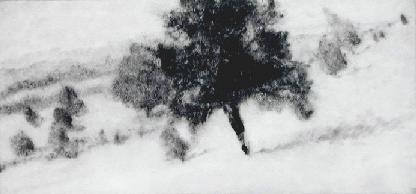Why Artists Use Monotype
A maker of woodcuts and etchings works carefully because each cut into the surface is final - there is no turning back when you have chiselled a piece of wood from an woodcut, or made an incision in a copper plate. Monotype is different. You paint a picture on a surface and while the oil or ink remain wet, you can can modify it, moving objects, changing colors, shades, light values and the relationships in the image. You can continue to make changes until you are satisfied and then print the one unique result. Monotype allows great flexibility in planning, shaping and modifying the print - it is a form that invites spontaneity and freedom until the picture seems to work best. Rostow and Jung said about monotype in 1999: "The question arises as to why a monotype and not a painting or watercolor? Why a 'print'? The answer may be that a great deal of surprise is built into the printmaking process where the image is: reversed, the image varies depending on how it's inked, how much pressure is applied, is it printed by an etching press or by hand using a baren? There are a lot of unpredictables involved and the spontaneity of the process demands energy, improvisation, gesture, expressiveness and directness. The artist must also appreciate the lushness and sensuality of working with ink."Tucker Hill sets himself the challenge of capturing, in monochrome color of black or dark brown, the light and shade, the glow and shadow of a country scene that he has captured in a photograph. The monotype method is particularly suited for this. Since it is correctible, it also permits a freedom which leads to creativity, and perhaps to "accidents" that add something different and are retained. It is a print medium particularly amenable for painters. Because the paint he works with is fresh he can wipe and erase, redo, and change relationships of objects and light, and see the effect of the change. This method differs from woodcut or lithograph where the result can only be seen after a print is run, when it is normally too late to make changes. Monotype is a fluid, flexible method of print-making where the result can be previewed, and the effects modified before the final print is struck. A recent
monotype exhibit in Washington, DC's National Gallery of American Art noted
that many artists who normally work in another medium use monotype for
"its spontaneity, its potential for chance effects, and its flexibility."
|
|||||||||||||||
